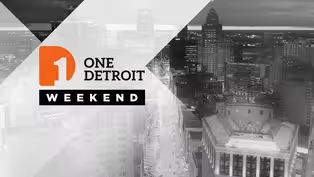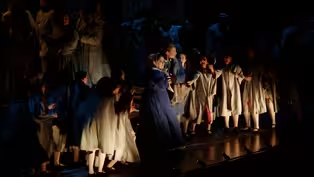
Detroit artist, designer Mike Han debuts his solo exhibit
Clip: Season 8 Episode 13 | 6m 10sVideo has Closed Captions
Detroit artist Mike Han debuts his first solo exhibit during the Detroit Month of Design.
Detroit designer and artist Mike Han presents his debut solo exhibition at Playground Detroit during Design Core Detroit's 13th annual Detroit Month of Design. Han's inaugural solo exhibit, titled "Mike Han: United by Design," takes people on a captivating exploration of his creative practice, which is infused with Korean calligraphy techniques, graffiti inspiration, and modern design elements.
Problems playing video? | Closed Captioning Feedback
Problems playing video? | Closed Captioning Feedback
One Detroit is a local public television program presented by Detroit PBS

Detroit artist, designer Mike Han debuts his solo exhibit
Clip: Season 8 Episode 13 | 6m 10sVideo has Closed Captions
Detroit designer and artist Mike Han presents his debut solo exhibition at Playground Detroit during Design Core Detroit's 13th annual Detroit Month of Design. Han's inaugural solo exhibit, titled "Mike Han: United by Design," takes people on a captivating exploration of his creative practice, which is infused with Korean calligraphy techniques, graffiti inspiration, and modern design elements.
Problems playing video? | Closed Captioning Feedback
How to Watch One Detroit
One Detroit is available to stream on pbs.org and the free PBS App, available on iPhone, Apple TV, Android TV, Android smartphones, Amazon Fire TV, Amazon Fire Tablet, Roku, Samsung Smart TV, and Vizio.
Providing Support for PBS.org
Learn Moreabout PBS online sponsorship(attendees chatting) - Collaboration, for me, has been essential to what I do.
I collaborate because I don't have the skills to do all the things, and being able to work with people who are experts, who are really good at what they do, it allows us to both shine, and do the things that we both love to do.
This is my first gallery show in Detroit.
My first solo show.
I've never worn a suit to an opening.
So like, you know what?
Like, I need to, need to like, be respectful of it.
It's "Mike Han: United by Design," and the show features a lot of different collaborations with Gardner White, with Haddy, with SEE Eyewear, Leon Speakers, also collaborated with Mothfire Beer.
They're out of Ann Arbor.
So all these companies are local except for one, one of them, Haddy.
I think the thing I wanted to show most about the show is sort of the vision that I've had.
So I've been working on the things that have come to being, you know, are 10 years, you know, 15 years in the making.
And so this idea of a sustainable lifestyle brand is from day one what I've wanted to build.
I've had a desire to want to learn how to live well through the art practice.
And so if I really want to do that, then I want to then make products that surround our lives, that are in our homes, that we use on a day-to-day basis, that are part of the solution to that problem, right?
How do we learn how to live well?
So, you know, home goods like, you know, tables, and rugs, and you know, speakers, and all these things working towards building the House of Han.
And so to be able to tell that complete story of how we live and live well, that's the ultimate goal.
And so I think the show begins to start to put all those pieces together where you see, you know, jackets, and sunglasses, and tables, and wall hangings, and rugs, and speakers, and you have music, and you have everything there except for food, you know?
And so it feels sort of like you're in a home, instead of a gallery.
And I think that warmth of being inside space that's also beautiful is really the ultimate takeaway.
How can you transform this, the perception of sustainability and just make it so it's beautiful, and it's good, and you want to use them.
And so with the rugs, for example, with Gardner White, they're made out of jute, so they're natural material, natural fiber rug, that we're then hoping to then produce and make available in all their stores.
And so, you know, being able to have something of that size compared to the same size of one of my paintings, you know, the price points are dramatically different.
And so the rugs would be something that everybody would be able to consume and get to love.
They're non-precious, but they make you feel wonderful.
And if they can be, you know, good for the environment as well, or at least not harm the environment, then that's, to me, a very exciting brand to build, is one that has a reason to grow, has a need to get bigger.
Minoru Yamasaki, you kind of see it here, yeah, these were salvaged in the train.
- [Attendee] Oh, it's salvaged.
- I believe the office is based here.
So I essentially vandalized a set of Minoru Yamasaki blueprints and Albert Kahn blueprints, you know, two of the most famed architects in the city of Detroit.
They are salvaged blueprints, the documents that were found, and they're quite weathered.
They're from, I think they're both roughly from about the '60s as prints.
They're not original drawings, but it's a series I call "Modern Vandalism," as I'm very much inspired by graffiti.
The salvaged blueprints are documents that were designed for very specific purpose.
They were drawn to, you know, create plans to help you build something.
And then once those things are built, those documents have very little value.
They no longer serve a purpose, in which they were intended.
And so they collect dust.
And so as something that is essentially garbage, that has lost its usefulness, I then vandalize and destroy these documents, in order to shine the light on them.
So now instead of collecting dust in the basement, these things end up on people's wall.
They end up framing these things and putting them on their walls.
In a very, I think, interesting way, this act of destruction has become an act of preservation.
The Minoru Yamasaki prints that I have in the show, they were actually painted with an ink that's made from sequestered carbon.
So it's a technology that was invented by these guys from MIT, it's company founded called Air-Ink.
And they are working to solve the problem of air pollution in India from, from their home.
And so taking that air pollution from factories and turning it into something functional, and then applying that, you know, sequestered carbon onto these salvaged blueprints, again, it speaks to then this layer of how I'm aspiring to live.
- [Attendee] Awesome.
(attendees chatting) When they go to the show, you know, I guess I want them to feel comfort, you know, I want them to feel joy, and I'm hoping that maybe they become inquisitive.
Start to wonder why, you know, the blueprint paintings are made, you know, and whether the destruction of them by me marking, you know, on blueprints made by Albert Khan and made by Yamasaki, you know, why that happened, and why it's good, you know, or if it's good, that they question everything that's in there, and why it's in there.
And if these things should be made.
Renaissance in my mind is told multiple times throughout the series.
Michigan book bans: The controversy of literary censorship
Video has Closed Captions
Clip: S8 Ep13 | 6m 34s | One Detroit learns about the state of book bans and literary censorship in Michigan. (6m 34s)
One Detroit Weekend: September 29, 2023
Video has Closed Captions
Clip: S8 Ep13 | 2m 48s | Check out some fun fall events happening around metro Detroit on “One Detroit Weekend.” (2m 48s)
Three operas make Detroit debut during Detroit Opera season
Video has Closed Captions
Clip: S8 Ep13 | 5m 55s | Three operas are making their Detroit debut during the Detroit Opera’s 2023-24 season. (5m 55s)
Providing Support for PBS.org
Learn Moreabout PBS online sponsorship
- News and Public Affairs

Top journalists deliver compelling original analysis of the hour's headlines.

- News and Public Affairs

FRONTLINE is investigative journalism that questions, explains and changes our world.












Support for PBS provided by:
One Detroit is a local public television program presented by Detroit PBS


